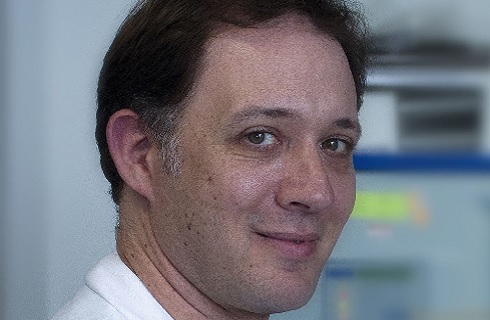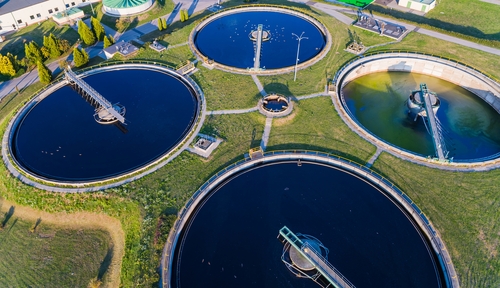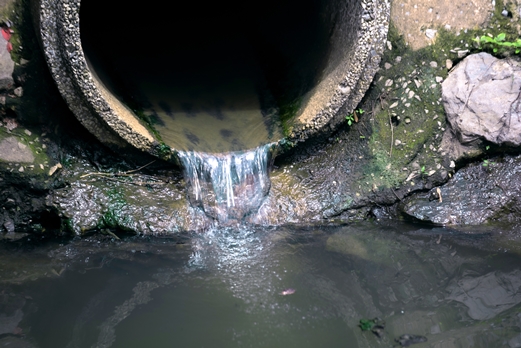'We don't have to demonstrate we can do it anymore, we need to demonstrate how well we can do it'

Dr Andrew Singer says surveillance of wastewater will be a 'game-changer' for monitoring COVID-19 and other disease outbreaks
By analysing the quantity of viral RNA found in wastewater, scientists can now estimate the number of live cases of COVID-19 in a locality and predict spikes in hospital admissions up to 10 days in advance.
Dr Andrew Singer, a senior scientist at the UK’s Centre for Hydrology and Ecology, is leading the UK’s National COVID-19 Wastewater-Based Epidemiology Surveillance Programme. He hopes this NERC-funded project will lead to a national system of ‘sentinel’ sewage works which acts as an early warning system, not just for local spikes of COVID-19 but other pathogens and public health problems.
If you were able to set up a fully operational national surveillance system tomorrow, what would it look like, and what do you think it could achieve in terms of informing our response to COVID-19?
You would have a series of ‘sentinel’ sewage works that tell you how the disease is progressing within certain communities, which complements the evidence that is gathered through testing and the apps that people are using. You may have something like 50 to 100 sewage works that are measured at least every other day. And that sample is analysed in a quantitative way, as best you can, and you would see the trend, and that could be presented alongside the data that is presented currently about hospital admissions and deaths.
The evidence so far is that this would give you insight into trends four to five days ahead of data from hospital admissions, at a bare minimum. That gap could be as long as 10 days.
A wastewater surveillance approach not only captures what will show up in the hospital a week later, but will also be capturing the asymptomatic shedders. We can estimate in each of the sample populations how many people are likely to have had COVID at any one time, over a span of months, and what proportion of the population has yet to have been infected. And so it will hopefully then be able to inform our estimates of spread and herd immunity too.
The problem is that there are 9,000 sewage works in the UK. When the virus first appeared in the UK there may have been just three or four at most that would have had coronavirus passing through them. So there's the problem of having the right sentinel wastewater treatment plants as part of the monitoring network.
That’s a bit of a guessing game, but I think organisations like the Office of National Statistics could help us understand the population in a statistical way. Deciding what is a sentinel and what are the characteristics that make one better than another is an important job, and it is one of the tasks we are working on together.
 Choosing which of the UK's 9000 sewage works to sample - and when - is a key decision, especially when case numbers are very low. Small isolated outbreaks can easily be missed unless sampling occurs within minutes of the affected households flushing their waste away.
Choosing which of the UK's 9000 sewage works to sample - and when - is a key decision, especially when case numbers are very low. Small isolated outbreaks can easily be missed unless sampling occurs within minutes of the affected households flushing their waste away. Is ‘wastewater epidemiology’ a new idea, or has it been used in the past to track other kinds of disease outbreaks?
If you look back at the first SARS outbreak, in 2003, only China was really doing wastewater testing. It wasn't so much surveillance, but just recognising that the virus might be transmitted in wastewater.
As far as tracking different disease outbreaks, I'm only aware of its use as part of a WHO polio surveillance programme, which complements the vaccination programme. They know where to vaccinate based on the shedding of the polio virus in the wastewater. There are other isolated cases where wastewater is used to monitor public health – but until now, they’ve been mostly academic exercises, not necessarily public health initiatives.
When did people realise this could be really useful to help track COVID-19 outbreaks?
Very quickly, in the first month or so of the pandemic, we had at least ten countries who were already starting to do the work. The Netherlands was first off the mark to publish something, and also they have had the support to make it a national programme.
The UK wasn't far behind – there is a group in Bangor who did get funding to do it very early, as early as March.
We don't have to demonstrate we can do it anymore, we need to demonstrate how well we can do it, and how accurate the numbers we’re getting are. How clever are the models to correlate the amount of viral RNA that you're getting to numbers of cases? That's where the science is right now.
So how do you convert the quantities of SARS-CoV-2 RNA you find in a sample into an estimate of COVID-19 infections?
There are numerous parameters that contribute to determining the relationship between viral RNA in wastewater at the point of sampling and the number of people shedding in the catchment. The variables include the shedding rate in different members of the population, the dilution and composition of the waste stream, the length of time spent in the sewage system, and the recovery efficiency of virus from sample.
Our project aims to examine all these either directly or by acquiring the data from other studies or simulations. For example we're going to be relying on other people internationally to collect data about the shedding of the virus – how much does a child shed compared to an adult? When is the maximum amount of shedding happening, and how long does shedding last after recovery? At the moment there is literature that says almost anything that you want to say. There's studies saying that you shed maximally before you know you're infected, and there’s cases of people who were hospitalised and are shedding 60 days after they've started to feel better. That’s something we’ll have to get a handle on.
During lockdown it was quite easy to predict how many people were going to be contributing to the sample, because everyone was at home – you just count the number of homes. As people are starting to return to work, you might have to have multiple markers to help estimate the numbers of people that were in that sample. We are all shedding mitochondrial RNA into wastewater too, and that is a potentially useful tool for estimating how many people were actually contributing to the sample that you've acquired.
Presumably when and where you sample is crucial too?
Yes. If you’re monitoring London sewage works where millions of people’s waste goes, and the infection rate is really quite minimal, you'll never find them. If there is one person in a catchment where there’s sewage from 5,000 people, you might be able to detect that, but to do so you have to sample at the right time after that person flushes their toilet. If you're not sampling during that five to ten minutes after they flush, you'd miss them.
Your sampling strategy is really quite important. If you're at zero cases and you want to spot an outbreak, then if you don't sample frequently enough then when something emerges you may miss it. When the infection rate is high, then you’ll find COVID everywhere. So the purpose of the approach needs to be continually revisited – are you monitoring for evidence of a spike, or downward trajectory? What do you want to know?
These are all the considerations that have to be made, and there's always trade-offs. I think that's where the science is – figuring out how to do this as all of the variables are changing, and many of them are unknown. You have to develop a sort of rulebook for where you go when certain scenarios emerge.
Do you have wastewater samples going back to the start of the year that could be used to help us understand the pandemic more broadly?
It's a no-brainer now to say that it would be great to have known how early COVID-19 was in the UK. Italy showed that it was circulating in December through wastewater, and there's every reason to expect that we had it in December as well. But creating an archive of sewage was a hard argument to make until now, when you see how useful it can be. Fortunately, some academics were taking wastewater for other purposes and researchers have been able to go ‘into the past’ to see what was where and when. But it’s difficult because coronaviruses are susceptible to detergents and aren't necessarily stable after having been frozen. So the fact that you can’t detect it might mean that it has been degraded.
 A variety of research groups in the UK are also looking at whether COVID-19 can be transmitted through exposure to sewage and wastewater.
A variety of research groups in the UK are also looking at whether COVID-19 can be transmitted through exposure to sewage and wastewater. Another question that your group is looking at is whether wastewater is actually a potential source of COVID-19 transmission too. What have you found?
There are three groups looking at this – one at Edinburgh, one at the London School of Hygiene and Tropical Medicine and one at Imperial College. We’re asking questions such as: how much of the virus in wastewater can cause infection? If you have 100 particles, are 99% of them non-infectious or is it 99% infectious? That’s really important.
When you think that the majority of the world doesn't have sewers, then you have to ask the question about the risk of transmission for those coming into contact with waste contaminated water. The question is probably not a hugely important question for the UK, but it’s an occupational health issue for wastewater treatment operators and it could become an environmental issue too. We might have discharges into the environment which is the untreated sewage or treated wastewater that is not effectively inactivating all of the virus. What is the risk for transmission to wildlife and humans?
If wastewater surveillance been in place at the beginning of the pandemic, our response and success tacking COVID-19 might have been completely different, right? It should at least improve how we handle a future pandemic in future.
It is absolutely a game changer. That is why I think it was such an easy sell for so many governments once they got the first published evidence of early detection. The UK Government decided that this was something that they needed to do nationally very quickly – literally a couple of days after the publication, Boris [Johnson] went on the news and said “we're going to do this through the ‘Joint Biosecurity Centre”.
It’s such an easy sell when you realise what kind of insights you can gain through very little investment - when you think that hundreds of billions of pounds are now being sent to different parts of the economy to help it recover from a pandemic that we didn't see coming. But if we did see it coming - well, we don't know how it would have played out, but it certainly would have played out in a less costly way. Not only economically, but with lives.
If such a national surveillance system was set up, are there any other potential functions that it could serve in terms of public health?
That is exactly where I am hoping this will lead. If there is an investment in the academic expertise needed to do this, which we didn't really have before, what we will have by the end of this pandemic is groups across the country that have developed the expertise needed to do pathogen surveillance on wastewater.
We happen to be doing this on a virus that is a little bit more difficult to detect than other pathogens, because it is susceptible to detergents. In that sense, we're actually building capacity with a slightly more difficult pathogen than we might want to do surveillance on later, like E.coli or norovirus. The expectation, I think, from the Public Health England and the Environment Agency, is that the investment that is being made now will be used to help set something like that up into the future. I hope this translates in to a reality. I see no reason why it shouldn't.
Dr Andrew Singer is a senior scientist at the UK Centre for Ecology and Hydrology. With a background in soil, water and pollution science, he is currently leading the National COVID-19 Wastewater-Based Epidemiology Surveillance Programme, a NERC-funded project through the COVID-Rapid Response Call.


